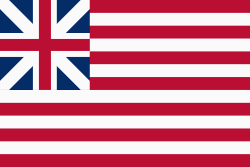I receive interesting mail on occasion.
Recently, I got a letter from George W. Bush’s Presidential Library. That went in the garbage. That was followed by a letter from John Boehner; he thinks taxes are too high, when the federal tax burden now is lower than at any time in the last fifty years, going back to the Truman administration.
And then, Colonial Williamsburg sent me two letters. Well, okay, one was a package; they sent me a tote bag and a Christmas ornament.
I’ve been a member of the Colonial Williamsburg Foundation for the past five years. I’ve never been to Colonial Williamsburg; I should rectify that someday.
Besides sending me a tote bag and a Christmas ormnament, they were hitting me up for money.
One thing they want to sell me? A Grand Union Flag. A flag of thirteen stripes, alternating red and white, with the Union Jack (absent the St. Patrick’s Cross representing Ireland) in the canton.
 It’s a pretty good deal they’re offering — eighteen dollars for a 3′ x 5′ flag. Confuse the neighbors on July 4th. 😉
It’s a pretty good deal they’re offering — eighteen dollars for a 3′ x 5′ flag. Confuse the neighbors on July 4th. 😉
As I read the flyer they sent about the flag, some musings came to the fore.
The Grand Union Flag is, as many historians have noted, identical to the flag flown by the British East India Company.
That, however, was not my musing.
Rather, I realized that the stripes on the Grand Union Flag don’t represent anything at all.
On the American flag, yes. The stripes represent the thirteen original states.
However. When the Grand Union Flag was first flown, in late 1775, there were more than thirteen British colonies in North America. The flag could easily have had fifteen, sixteen, even seventeen stripes, had the stripes represented the colonies. They can’t even be said to represent the colonies in rebellion at that point in time, as Georgia was still on the fence
Perhaps it was an aesthetic choice to have thirteen stripes for that first flag. And then, when the colonies declared their independence and the Union Jack canton was replaced with a field of white stars on a blue background, the number thirteen had a greater significance. Retroactive history, one might say.
Consider this your history lesson for the day.
And eighteen dollars is really tempting…
I thought the British East India Company flag was just red and white with no blue in? I have seen the flag with the union jack on before but was looking for the other red and white one, which is correct?
The BEIC flew several flags; the Wikipedia article shows several, with their “main” flag showing thirteen stripes and the Union Jack in the canton, identical (or very nearly so) to the Grand Union flag used by the British North American colonies in 1775 and 1776.